
Oxon Cove Park and Oxon Cove Farm is a national historic district that includes a living farm museum operated by the National Park Service, and located at Oxon Hill, Prince George's County, Maryland. It is part of National Capital Parks-East. It was listed on the National Register of Historic Places in 2003.
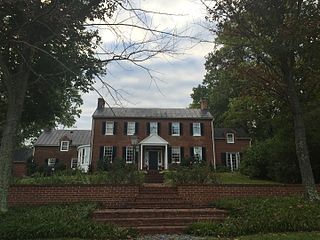
East Oaks is a historic home and farm complex and national historic district located at Poolesville, Montgomery County, Maryland. It is a 156-acre (0.63 km2) farm complex consisting of a 2 1⁄2-story, c. 1829 Federal-period brick residence situated on a knoll surrounded by agricultural buildings and dependencies whose construction dates span more than a century. The complex of domestic and agricultural outbuildings includes a brick smokehouse, sandstone slave quarter, stone bank barn, stone dairy, and log and frame tenant house which are contemporaneous with the construction of the main dwelling. Other agricultural buildings include a small frame barn and machinery shed/corn crib from the end of the 19th century, and a block dairy barn from the mid 20th century.

Thainston is a farm complex and national historic district in La Plata, Charles County, Maryland, United States. The main house is a two-story, L-shaped brick house built in 1865 and enlarged early in the 20th century. It was designed by Eben Faxon, a Baltimore architect, and constructed under the supervision of Charles Ogle, a building contractor also from Baltimore. The farm developed between 1865 and the 1930s. Included on the property are a number of early dependencies, including a wellhouse, a brick dairy, a storage building, and a meathouse. A frame garage and large chicken house, both dating from the early 1900s, are on the property. There is also a collection of agricultural buildings including: tobacco barns, cattle barns, and equipment sheds clustered around a corncrib/granary. There are three frame tenant houses, several associated sheds, a probably early building site, an early well, a pit remaining from a former ice house, and the former ice ponds. Another early-20th century building, a tobacco barn, stands in a field to the west of the main grouping of agricultural buildings.

The Inns on the National Road is a national historic district near Cumberland, Allegany County, Maryland. It originally consisted of 11 Maryland inns on the National Road and located in Allegany and Garrett counties. Those that remain stand as the physical remains of the almost-legendary hospitality offered on this well-traveled route to the west.
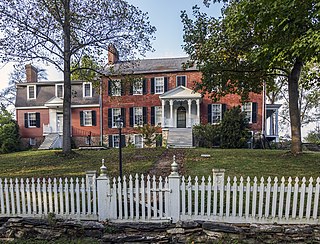
Hopewell is a set of historic homes and farm complexes located at Union Bridge, Carroll County, Maryland, United States. It consists of four related groupings of 19th century farm buildings. The Hopewell complex consists of two historic farms: Hopewell and the smaller F.R. Shriner Farm.

Hoffman Farm is a historic farm complex located at Keedysville, Washington County, Maryland, United States. It consists of an 1840s Greek Revival style two-story brick dwelling, adjacent brick slave quarters, a Federal-style stone house built about 1810 over a spring, a frame wagon shed, a log hog barn, and a frame forebay bank barn. The farm buildings were used as a hospital during the American Civil War in Battle of Antietam from the day of the battle on September 17, 1862, and through the following month. Over 800 men were hospitalized in the barn, house, outbuildings, and grounds.

Mount Airy, also known as Grove Farm, is a historic home located at Sharpsburg, Washington County, Maryland, United States. It is a 2 1⁄2-story Flemish bond brick house, built about 1821 with elements of the Federal and Greek Revival styles. Also on the property are a probable 1820s one-story gable-roofed brick structure that has been extensively altered over time, a late-19th-century frame barn with metal roof ventilators, a 2-story frame tenant house built about 1900, and a mid-20th-century cinder block animal shed. It was used as a hospital for Confederate and Union soldiers following the Battle of Antietam. On October 3, 1862, President Abraham Lincoln and General George McClellan visited Mount Airy, an event recorded photographically by Alexander Gardner.

The William and Catherine Biggs Farm is a historic home and farm complex located at Detour, Carroll County, Maryland, United States. The complex consists of a stone house, a stone outbuilding / summer kitchen, a frame bank barn, and an early-20th-century concrete block barn, dairy building, and silo. The house is a two-story, five-by-two-bay structure with a three-by-two-bay, two-story rear wing. It is built primarily of rubble stone.

The Bennett-Kelly Farm is an historic home and farm complex located at Sykesville, Carroll County, Maryland, United States. The complex consists of a stone and frame house, a stone mounting block, a stone smokehouse, a frame bank barn, a frame wagon shed, a frame chicken house, a concrete block dairy or tool shed, and a stone spring house. The original mid-19th century stone section of the house is three bays wide and two stories high. The house features a one-bay Greek Revival pedimented portico with Doric columns. It is an example of a type of family farmstead that characterized rural agricultural Carroll County from the mid 19th century through the early 20th century.

The Englar-Schweigart-Rinehart Farm is a historic home and farm complex located at Westminster, Carroll County, Maryland, United States. It consists of a brick house, a brick smokehouse, a stone springhouse, a frame bank barn, and a frame poultry house. The house is a two-story, five-by-two-bay Flemish bond brick structure painted white, and set on a rubble stone foundation. The house was constructed in 1809 or 1810. The farm is significant for its illustration of how German-Swiss immigrants to Maryland became acculturated to the dominant English culture.
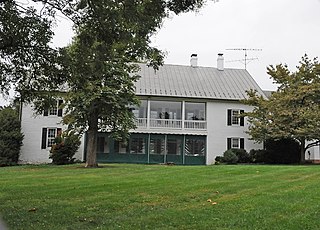
Friendship Valley Farm is a historic home and farm complex located at Westminster, Carroll County, Maryland, United States. It was established in the late 18th century. About that time a 2 1⁄2-story "T"-shaped main house was built of brick on a stone foundation. It was later expanded to its current "H" shape. One of the small log cabins still standing near the house was once a slave cabin. It was later used as a smoke house. Also on the property is a large brick wash-house and summer kitchen built in 1860, with a bell tower on the roof.
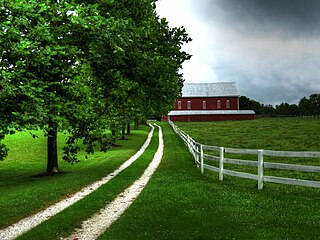
The Andrew P. Frizzell House and Farm Complex is a historic home and farm complex located at Westminster, Carroll County, Maryland, United States.

The Stoner–Saum Farm is a historic home and farm complex located at Union Bridge, Carroll County, Maryland, United States. The complex consists of a brick house, a frame bank barn, a brick smokehouse, a stone ice house and summer kitchen, a stone wagon shed, and several other frame farm outbuildings. The house is a two-story, five-bay by two-bay structure with a rubble stone foundation.

Jacob F. Shaffer Farm is a historic home and farm complex located at Millers, Carroll County, Maryland. The complex consists of a brick house built in 1854, a rare stone bank barn, a frame summer kitchen, and a frame corn crib. The house is a two-story, three-bay wide, banked Federal / Greek Revival style brick structure with Flemish bond on the east-facing facade.
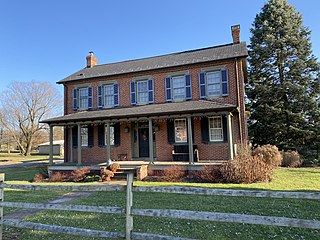
The Winemiller Family Farm is a historic home and farm complex located at Taneytown, Carroll County, Maryland, United States. The complex consists of a large two-story brick house built about 1865, a frame bank barn, and several outbuildings. It is a representative example of a type of family farm complex that characterized rural agricultural Carroll County from about 1850 through the early 20th century.

Keefer–Brubaker Farm, also known as the Oscar Fogle Farm, is a historic home and farm complex located at Taneytown, Carroll County, Maryland. It consists of a two-story six-by-two-bay log-and-frame house which is partially encased in brick and rests on a rubble stone foundation Also on the property is a frame summer kitchen, a combination smokehouse/dry house, a frame springhouse, a shop building, a bank barn, a dairy, a hog pen, a tool shed, poultry house, and several more recent buildings. It is a representative example of a family farm complex which spans the period from the late 18th century to the mid 20th century.

Meadow Brook Farm, also known as the John Roop Farm or Samuel Roop Farm, is a historic home and farm complex located at Westminster, Carroll County, Maryland. The complex consists of the Victorian farmhouse and several period outbuildings including an 1809 two-story brick washhouse, brick smokehouse, brick privy, and brick tenant house. The house is a two-story brick structure that was built in the Pennsylvania German style about 1805. It has the typical gable roof, symmetrical façade, and "L"-shaped plan In 1868, the exterior and interior were remodeled to contemporary rural Victorian standards. The house was built during a period of significant immigration of Pennsylvania Germans into Maryland.
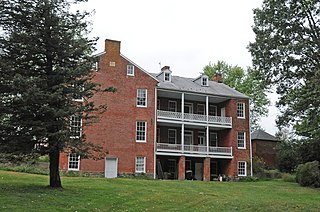
The John Orendorff Farm is a historic home and farm complex located at Westminster, Carroll County, Maryland, United States. The complex consists of a brick house, a brick privy, a brick smokehouse, a frame barn, a frame hog pen, a frame wagon shed, two poultry houses, and a feed house. The house is a five-by-two-bay brick structure, built in 1861 in the Italianate style. It has a 2 1⁄2-story, six-by-two-bay brick ell on the north side.

Rockland Farm is a historic home and farm complex located at Westminster, Carroll County, Maryland, United States. The complex consists of a brick house, the stone foundation of an 18th-century springhouse, as well as a large frame barn and a corn crib, both dating to the late 19th century. The house, built in 1795, retains the Pennsylvania German traditional three-room plan with a central chimney. It is a two-story, three-bay by two-bay brick structure on a stone foundation built into a slope.

Waterloo is a historic home located at Princess Anne, Somerset County, Maryland. It is a two-story four-room plan Flemish bond brick house, Georgian-period brick house built about 1750-1760 by Henry Waggaman. It features a Corinthian columned porch with a roof top balustrade. Also on the property is a group of outbuildings including a doctor's office, a five-car garage, a frame caretaker's house, a small pump house, and the Waggaman-Riggin family cemetery. During the 19th century the property was owned by several locally prominent families until 1864, when the farm was purchased by the county for an almshouse. The county retained ownership of the property until 1948. The house was operated as a Bed & Breakfast for several years, but is now under private ownership.





















